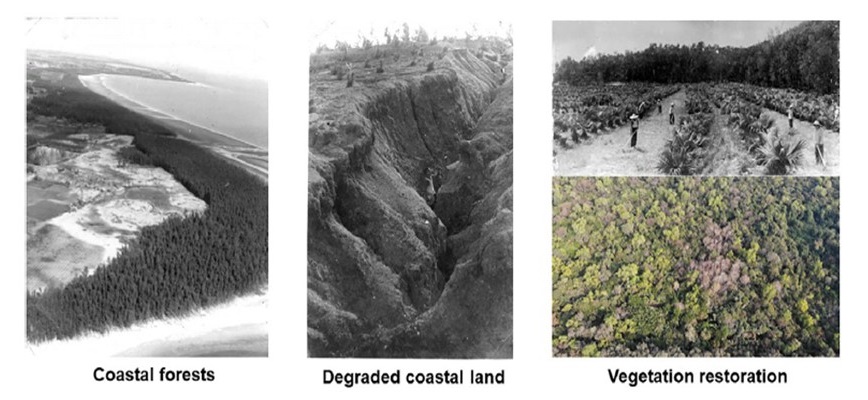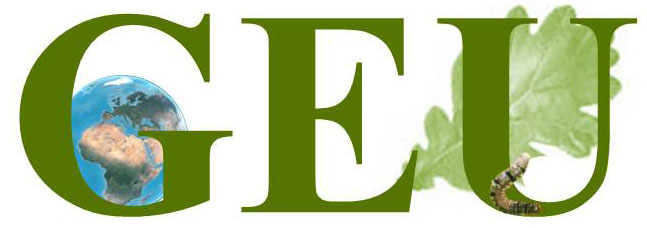
In a new study published in the journal Global Change Biology authors studied the linkages between different afforestation practices and soil biodiversity in a tropical coastal forest in South China. Images show the degraded coastal land and vegetation restoration in the study area; image source: Wu et al. Global Change Biology.
The importance of forests in the global carbon cycle that sustains life on Earth is undisputable. The multifunctional roles of forests extend to many aspects such as moderating air temperature and supporting a vast array of biodiversity on Earth. Forests also provide economic (e.g. timber, food, and fiber) and social benefits (e.g. subsistence for local populations and cultures. However, global climate change and human activities such as farming, mining, infrastructure expansion, are causing deforestation and subsequent degradation of soil properties and functions.
Afforestation, act or process of establishing a forest especially on land not previously forested, is an effective method to restore degraded land. Afforestation methods vary in their effects on ecosystem multifunctionality, but their effects on soil biodiversity have been largely overlooked.
In a new study published in the journal Global Change Biology authors studied the linkages between different afforestation practices and soil biodiversity in a tropical coastal forest in South China. The afforestation practices were initiated in the 1960s with no afforestation practices (bare land) and Eucalyptus exserta rotation monoculture. Later, in 1974, some Eucalyptus forests were clear-cut and reforested with native tree species. The study tested whether afforestation with native tree mixtures would restore the community composition, diversity, and abundance of diverse soil biota to levels of undisturbed native forests, while authors expected these effects to be less in Eucalyptus rotation monoculture forests. Furthermore, they also tested if afforestation with native tree mixtures would increase functional characteristics of soil biota more than afforestation with Eucalyptus rotation monocultures.
Sixty years after afforestation from bare land, plant species richness and the abundance of plant litter (398 ± 85 g m−2) and plant biomass (179 ± 3.7 t ha−1) in native tree species mixtures were restored to the level of native forests (287 ± 21 g m−2 and 243.0 ± 33 t ha−1, respectively), while Eucalyptus monoculture only successfully restored the litter mass (388 ± 43 g m−2) to the level of native forests. Soil fertility in Eucalyptus monoculture and species mixtures was increased but remained lower than in native forests.
Authors give the example of soil nitrogen and phosphorus concentrations in species mixtures (1.2 ± 0.2 g kg−1 and 408 ± 49 mg kg−1, respectively; p < 0.05) were lower than in native forests (1.8 ± 0.2 g kg−1 and 523 ± 24 mg kg−1, respectively; p < 0.05). Soil biodiversity, abundance (except for nematodes), and community composition in species mixtures were similar or greater than those in native forests. In contrast, restoration with Eucalyptus monoculture only enhanced the diversity of microbes and mites to the level of native forests, but not for other soil biota.
According with this study, afforestation with native species mixtures can end up restoring vegetation and most aspects of the taxonomic and functional biodiversity in soil whereas monoculture using fast-growing non-native species cannot. “Native species mixtures show a greater potential to reach completely similar levels of soil biodiversity in local natural forests if they received some more decades of afforestation. Multifunctionality of soil biotic community should be considered to accelerate such processes in future restoration practices”, highlights Dr. Wenjia Wu from the Key Laboratory of Vegetation Restoration and Management of Degraded Ecosystems & CAS Engineering Laboratory for Vegetation Ecosystem Restoration on Islands and Coastal Zones, China.
“Although sixty years afforestation with native species did not reach the full level of soil fertility, abundance, and functional characteristics of belowground community of the more than 200-year-old native forest, certain traits of diversity of soil biota reached similar levels. This indicates that the overall habitat restoration may take several decades, with likely consequences for ecosystem functioning. However, the afforestation with native species can end up reaching similar levels of diversity than native forests whereas plantations using fast-growing non-native species cannot”, summarizes Prof. Josep Penuelas from CREAF-CSIC Barcelona.
Reference: Wu, W., Kuang, L., Li, Y., He, L., Mou, Z., Wang, F., Zhang, J., Wang, J., Li, Z., Lambers, H., Sardans, J., Peñuelas, J., Geisen, S., Liu, Z. 2021. Faster recovery of soil biodiversity in native species mixture than in Eucalyptus monoculture after 60 years afforestation in tropical degraded coastal terraces. Global Change Biology. doi: 1 0.1111/gcb.15774, in press..






